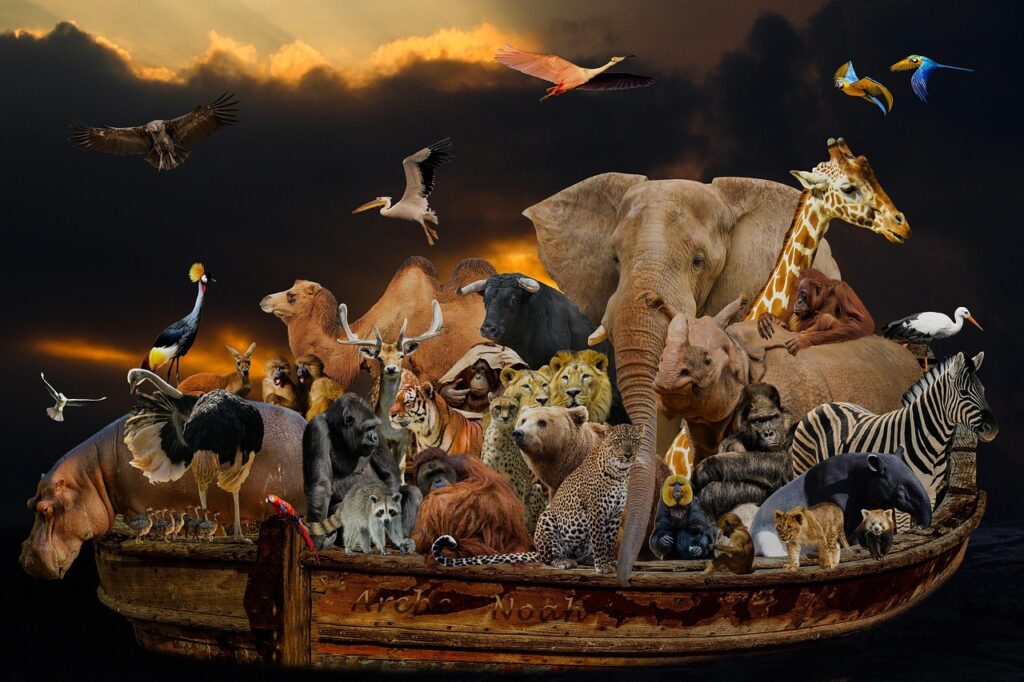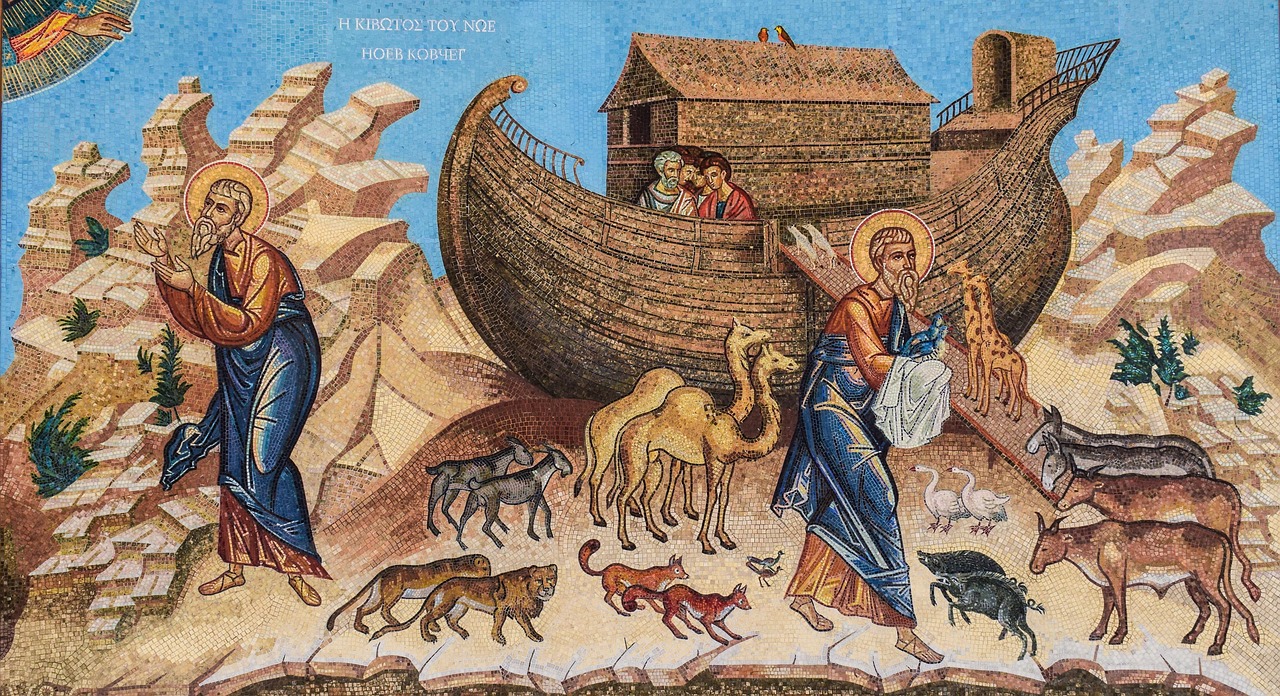Let’s get this straight: according to the biblical narrative, a 600-year-old man built a giant wooden boat, wrangled up every species on Earth—kangaroos from Australia, polar bears from the Arctic, anacondas from the Amazon, termites (and somehow didn’t let them eat the boat), and even penguins waddling in from Antarctica—and got them all to live together peacefully for over a year… during a global flood.
At some point, you have to stop calling it faith and start calling it a logistical nightmare wrapped in ancient mythology.
The Blueprint from Heaven?
According to Genesis 6:14–16, God gives Noah detailed construction plans:
“Make yourself an ark of gopher wood… The length of the ark shall be three hundred cubits, its breadth fifty cubits, and its height thirty cubits.”
A cubit is an ancient unit of length based on the distance from the elbow to the tip of the middle finger—basically, a forearm’s length. Of course, that means it wasn’t standardized, but on average:
- 1 cubit ≈ 18 inches (or 45.72 cm)
There are actually different versions:
- Hebrew cubit: ~17.5 inches (44.5 cm)
- Egyptian cubit: ~20.6 inches (52.3 cm)
- Royal cubit: up to 21.6 inches (55 cm)
So how big was Noah’s Ark?
According to Genesis 6:15:
“The ark is to be 300 cubits long, 50 cubits wide, and 30 cubits high.”
If we go with the standard 18-inch cubit:
- Length: 300 cubits = 450 feet (~137 meters)
- Width: 50 cubits = 75 feet (~23 meters)
- Height: 30 cubits = 45 feet (~14 meters)
That’s roughly the size of a modern cargo ship—impressive, sure—but supposedly enough to house millions of species, plus food, water, and a functioning waste system. No blueprints, no shipbuilding experience, just divine DIY.
So yeah, it’s a pretty massive ship for the ancient world. But knowing what we do today about animal species, food logistics, waste management, and basic biology…
Do you really believe that a wooden boat of that size could fit millions of species, along with a year’s worth of food, fresh water, and enough ventilation to keep everything alive—without sinking, starving, or collapsing under its own weight?
In an age where we can Google the carrying capacity of a container ship in seconds, the real question is: Are we still pretending this story holds up under scrutiny, or are we just afraid to let it go?
Two by Two… or Fourteen by Fourteen?
The contradictions start early. Genesis 6:19–20 tells Noah to bring two of every animal, male and female.
But then Genesis 7:2–3 flips it:
“Take with you seven pairs of every kind of clean animal… and also seven pairs of every kind of bird.”
So which is it? And how did Noah sort out “clean” and “unclean” animals before Leviticus even existed?
The Real Animal Migration Mystery

Kangaroos don’t live in Mesopotamia. Neither do penguins, sloths, jaguars, or Komodo dragons. So how did they all arrive on time to board the ark? Did koalas trek across Asia with eucalyptus leaves in tow?
Even assuming divine teleportation, how did they get back to their native lands after the flood—without leaving a single fossil trail of their global roundtrip?
Meanwhile, On the Boat…

Let’s not forget the logistics. Every predator and prey, insect and herbivore, all packed into one wooden ship. No territorial fights? No extinction events? No pandemics? Not even a chewed beam from the termites?
Noah, age 600 (Genesis 7:6), was apparently the zookeeper, vet, janitor, and carpenter for an entire year. With no plumbing. No antibiotics. No modern tools. Just faith and pitch.
After the Flood: Humanity 2.0 (Now with Extra Inbreeding!)
After the waters recede (Genesis 8:4), the world is left with just eight humans. From them, every race, culture, and genetic variation supposedly springs forth.
This isn’t population science—it’s an ancient reboot myth. Not to mention a huge red flag for inbreeding.
And then the weirdest part: Noah, fresh off his hero status, gets drunk and naked in his tent (Genesis 9:20–21). When his son Ham sees him and tells his brothers, Noah curses Ham’s son (Genesis 9:24–25) to be a slave forever. Because… reasons?
Ecological Collapse, but Make It Biblical

Global flood = mass extinction. Yet after a year underwater, the Earth just… works again? Plants magically regrow. Ecosystems rebalance. The dodos don’t immediately go extinct (okay, maybe they did).
Genesis 9:13 says:
“I have set my rainbow in the clouds, and it will be the sign of the covenant between me and the Earth.”
According to the Bible, this was the first rainbow—ever. A brand-new phenomenon, created by God as a promise never to flood the world again.
But here’s the thing: we know how rainbows work. They’re not divine symbols; they’re optical physics. Rainbows are caused by light refracting, reflecting, and dispersing in water droplets. That means the ingredients for rainbows—sunlight and water—existed long before Noah ever picked up a hammer.
So what are we supposed to believe here? That light didn’t refract before this moment? That the laws of physics were different pre-flood? That nobody, not once, noticed a colorful arc in the sky during a rainstorm?
You don’t need divine intervention to explain a rainbow. You need sunlight, raindrops, and a basic understanding of how light bends. High school science class will do just fine.
So if a rainbow was meant to be some kind of cosmic gesture, the modern mind might ask:
Was God just waiting until post-flood to enable the laws of optics? Or was the story written at a time when people didn’t yet understand how light and water interact?
Also: where did all the water go?
Mythology in a Lab Coat
The tale of Noah’s Ark is often treated as a cute children’s story—painted on nursery walls with smiling giraffes and happy elephants poking out of a boat. But step back and really read it, and it’s not a feel-good tale. It’s a mass extinction story where the “hero” watches the world drown while saving a literal handful of people and animals—because a god regretted his creation (Genesis 6:6).
And yet, somehow, this is the story many still want taught alongside evolution in science classrooms.
Imagine if we did the same with Greek mythology. Taught the story of Prometheus stealing fire from the gods as an alternative to thermodynamics. Or insisted that Poseidon was a valid explanation for earthquakes.
The problem isn’t faith—it’s when faith pretends to wear a lab coat.
You can believe in symbolic meaning, poetic truth, or spiritual lessons all you want. But when ancient flood myths are passed off as literal history, we’re not educating. We’re storytelling with a straight face and hoping nobody notices the ark is sinking under its own contradictions.
